
The exhibition presents artistic approaches that examine the manifold power relations and processes concentrated in water as a material and as a cultural metaphor. It also aims to create a situation where we can leave behind the rather anthropocentric idea that water is merely a physiologically vital material, a resource to be exploited and rather consider it as something that can be regarded as an entity with a memory of its own and a substance that bounds us together in an intimate and tight network of other beings, that might even be far from us in space and in time.




The exhibition draws on the theory of hydrofeminism recently introduced by feminist philosopher Astrida Neimanis. The hydrofeminist logic defines the body as a largely water-based entity that, we may think, is almost hermetically obstructed by the external reality, while in fact our skin behaves more like a porous membrane that only delimits and separates it from the outside world – this insight makes us rethink the Western metaphysical tradition that determines the human body as a closed being. Water is constantly moving in and out of our bodies, not just by our basic biological functions (breathing, drinking, eating, urinating), but also as a consequence of our emotional reactions (crying, laughter, excitement). Since the amount of water found on the planet is constant, we are in fact connected to global systems through these visceral and intimate processes – since the fluid that fills our cells, that flows through in our veins and tear-ducts, that seeps through our pores, that is breathed out into the atmosphere meanders into rivers, flows into the seas and oceans, washes the coasts of islands and connects with other organisms in a continuous flow (and returns to and enters into other bodies and things). Water is the matrix that mediates people into a network shared with other entities – hence the idea of interpreting human beings in isolation from other species is difficult to sustain. According to the hydrofeminist onto-logic (and thus subverting an anthropocentric way of thinking), we are merely participants of the constantly wavering, surging, pulsating cycles inhabited by human and more-than-human entities. And water, as an archive, preserves the emotions, the bodies, the objects, and the movements that have passed through it and that it has passed through. This latter thought may also evoke the idea of a new kind of social, ecological and political kinship, awareness or responsibility.









Imprint
| Artist | Louis Henderson, Zsófia Keresztes, Birthe Leemeijer, The Otolith Group, prokaryote precariat, Sissel Marie Tonn |
| Exhibition | Web of Wet |
| Place / venue | Trafó Gallery, Budapest |
| Dates | 16 November 2019 – 5 January 2020 |
| Curated by | Judit Szalipszki |
| Website | trafo.hu/en |
| Index | Birthe Leemeijer Louis Henderson prokaryote precariat Sissel Marie Tonn The Otolith Group Trafó Gallery Zsófia Keresztes |
